Integrated Approaches for Field Mapping by Traditional Investigation and Satellite PSInSAR Data: Results from the Montemartano Landslide (Central Italy)
Abstract
1. Introduction
2. Study Area
2.1. Geological and Geomorphological Setting
3. Materials and Methods
3.1. Characteristic of Landslide Mass Materials and Field Monitoring Data
3.2. Historical Aerial Photographs
3.3. PSInSAR Technique
3.4. Hazard and Risk Assessment Method
4. Results
- -
- Step 1: Total landslide volume of about 7.7 Mm3 with very-high intensity (4);
- -
- Step 2: Very-high frequency (more than three events over 50 years), corresponding to a hazard level 44 (P4);
- -
- Step 3: Thirty-four buildings and streets on which a structural damage can occur (300);
- -
- Step 4: By combining the hazard (44) and the structural damage (300), a specific risk of 344 is obtained, falling in the risk level R4 (Step 5).
5. Discussion
6. Conclusions
Supplementary Materials
Author Contributions
Funding
Data Availability Statement
Acknowledgments
Conflicts of Interest
References
- Van Den Eeckhaut, M.; Hervás, J. State of the art of national landslide databases in Europe and their potential for assessing landslide susceptibility, hazard and risk. Geomorphology 2012, 139–140, 545–558. [Google Scholar] [CrossRef]
- Alexander, D.E. A brief survey of GIS in mass-movement studies, with reflections on theory and methods. Geomorphology 2008, 94, 261–267. [Google Scholar] [CrossRef]
- Assilzadeh, H.; Levy, J.K.; Wang, X. Landslide Catastrophes and Disaster Risk Reduction: A GIS Framework for Landslide Prevention and Management. Remote Sens. 2010, 2, 2259–2273. [Google Scholar] [CrossRef]
- Zhong, C.; Liu, Y.; Gao, P.; Chen, W.; Li, H.; Hou, Y.; Nuremanguli, T.; Ma, H. Landslide mapping with remote sensing: Challenges and opportunities. Remote Sens. 2020, 41, 1555–1581. [Google Scholar] [CrossRef]
- Guzzetti, F.; Mondini, A.C.; Cardinali, M.; Fiorucci, F.; Santangelo, M.; Chang, K.T. Landslide inventory maps: New tools for an old problem. Earth-Sci. Rev. 2012, 112, 42–66. [Google Scholar] [CrossRef]
- Bardi, F.; Frodella, W.; Ciampalini, A.; Bianchini, S.; Del Ventisette, C.; Gigli, G.; Fanti, R.; Moretti, S.; Basile, G.; Casagli, N. Integration between ground based and satellite SAR data in landslide mapping: The San Fratello case study. Geomorphology 2014, 223, 45–60. [Google Scholar] [CrossRef]
- Cencetti, C.; Conversini, P.; Radicioni, F.; Ribaldi, C.; Selli, S.; Tacconi, P. The Evolution of Montebestia Landslide (Umbria, Central Italy). Site Investigations, In-Situ Tests and GPS Monitoring. Phys. Chem. Earth (B) 2000, 25, 799–808. [Google Scholar] [CrossRef]
- Meisina, C.; Zucca, F.; Notti, D.; Colombo, A.; Cucchi, A.; Savio, G.; Gannico, C.; Bianchi, M. Geological interpretation of PSInSAR data at regional scale. Sensors 2008, 8, 7469–7492. [Google Scholar] [CrossRef]
- Calò, F.; Calcaterra, D.; Iodice, A.; Parise, M.; Ramondini, M. Assessing the activity of a large landslide in southern Italy by ground-monitoring and SAR interferometric techniques. Int. J. Remote Sens. 2012, 33, 3512–3530. [Google Scholar] [CrossRef]
- Allasia, P.; Manconi, A.; Giordan, D.; Baldo, M.; Lollino, G. ADVICE: A New Approach for Near-Real-Time Monitoring of Surface Displacements in Landslide Hazard Scenarios. Sensors 2013, 13, 8285–8302. [Google Scholar] [CrossRef] [PubMed]
- Rosi, A.; Vannocci, P.; Tofani, V.; Gigli, G.; Casagli, N. Landslide Characterization Using Satellite Interferometry (PSI), Geotechnical Investigations and Numerical Modelling: The Case Study of Ricasoli Village (Italy). Int. J. Geosci. 2013, 4, 904–918. [Google Scholar] [CrossRef]
- Scaioni, M.; Longoni, L.; Melillo, V.; Papini, M. Remote Sensing for Landslide Investigations: An Overview of Recent Achievements and Perspectives. Remote Sens. 2014, 6, 9600–9652. [Google Scholar] [CrossRef]
- Taramelli, A.; Di Matteo, L.; Ciavola, P.; Guadagnano, F.; Tolomei, C. Temporal evolution of patterns and processes related to subsidence of the coastal area surrounding the Bevano River mouth (Northern Adriatic)—Italy. Ocean Coast. Manag. 2015, 108, 74–88. [Google Scholar] [CrossRef]
- Mazzanti, P.; Bozzano, F.; Cipriani, I.; Prestininzi, A. New insights into the temporal prediction of landslides by a terrestrial SAR interferometry monitoring case study. Landslides 2015, 12, 55–68. [Google Scholar] [CrossRef]
- Di Matteo, L.; Romeo, S.; Kieffer, D.S. Rock fall analysis in an Alpine area by using a reliable integrated monitoring system: Results from the Ingelsberg slope (Salzburg Land, Austria). Bull. Eng. Geol. Environ. 2017, 76, 413–420. [Google Scholar] [CrossRef]
- Romeo, S.; Di Matteo, L.; Kieffer, D.S.; Tosi, G.; Stoppini, A.; Radicioni, F. The Use of Gigapixel Photogrammetry for the Understanding of Landslide Processes in Alpine Terrain. Geosciences 2019, 9, 99. [Google Scholar] [CrossRef]
- Miele, P.; Di Napoli, M.; Novellino, A.; Calcaterra, D.; Mallorqui, J.J.; Di Martire, D. SAR data and field surveys combination to update rainfall-induced shallow landslide inventory. Remote Sens. Appl. Soc. Environ. 2022, 26, 100755. [Google Scholar] [CrossRef]
- Trigila, A.; Iadanza, C.; Bussettini, M.; Lastoria, B. Dissesto Idrogeologico in Italia: Pericolosità e Indicatori di Rischio; Ispra, Italy, 2018; Rapporti 287/2018; 159p. Available online: https://www.isprambiente.gov.it/it/pubblicazioni/rapporti/dissesto-idrogeologico-in-italia-pericolosita-e-indicatori-di-rischio-edizione-2021 (accessed on 9 January 2023).
- Petitta, M.; Mastrorillo, L.; Preziosi, E.; Banzato, F.; Barberio, M.D.; Billi, A.; Cambi, C.; De Luca, G.; Di Carlo, G.; Di Curzio, D.; et al. Water table and discharge changes associated with the 2016–2017 seismic sequence in central Italy: Hydrogeological data and a conceptual model for fractured carbonate aquifers. Hydrogeol. J. 2018, 26, 1009–1026. [Google Scholar] [CrossRef]
- Valerio, E.; Tizzani, P.; Carminati, E.; Doglioni, C.; Pepe, S.; Petricca, P.; De Luca, C.; Bignami, C.; Solaro, G.; Castaldo, R.; et al. Ground Deformation and Source Geometry of the 30 October 2016 Mw 6.5 Norcia Earthquake (Central Italy) Investigated Through Seismological Data, DInSAR Measurements, and Numerical Modelling. Remote Sens. 2018, 10, 1901. [Google Scholar] [CrossRef]
- Valigi, D.; Mastrorillo, L.; Cambi, C.; Barchi, M.R.; Cardellini, C.; Checcucci, R.; Di Matteo, L.; Frondini, F.; Mirabella, F.; Viaroli, S.; et al. Springs discharge variations induced by strong earthquakes: The Mw 6.5 Norcia event (Italy, October 30th 2016). Rend. Online Soc. Geol. Ital. 2019, 47, 141–146. [Google Scholar] [CrossRef]
- Di Matteo, L.; Dragoni, W.; Azzaro, S.; Pauselli, C.; Porreca, M.; Bellina, G.; Cardaci, W. Effects of earthquakes on the discharge of groundwater systems: The case of the 2016 seismic sequence in the Central Apennines, Italy. J. Hydrol. 2020, 583, 124509. [Google Scholar] [CrossRef]
- Fronzi, D.; Di Curzio, D.; Rusi, S.; Valigi, D.; Tazioli, A. Comparison between Periodic Tracer Tests and Time-Series Analysis to Assess Mid-and Long-Term Recharge Model Changes Due to Multiple Strong Seismic Events in Carbonate Aquifers. Water 2020, 12, 3073. [Google Scholar] [CrossRef]
- Di Matteo, L.; Capoccioni, A.; Porreca, M.; Pauselli, C. Groundwater-Surface Water Interaction in the Nera River Basin (Central Italy): New Insights after the 2016 Seismic Sequence. Hydrology 2021, 8, 97. [Google Scholar] [CrossRef]
- Cambi, C.; Mirabella, F.; Petitta, M.; Banzato, F.; Beddini, G.; Cardellini, C.; Fronzi, D.; Mastrorillo, L.; Tazioli, A.; Valigi, D. Reaction of the carbonate Sibillini Mountains Basal aquifer (Central Italy) to the extensional 2016–2017 seismic sequence. Sci. Rep. 2022, 12, 22428. [Google Scholar] [CrossRef]
- Romeo, S.; Di Matteo, L.; Melelli, L.; Cencetti, C.; Dragoni, W.; Fredduzzi, A. Seismic-induced rockfalls and landslide dam following the October 30, 2016 earthquake in Central Italy. Landslides 2017, 14, 1457–1465. [Google Scholar] [CrossRef]
- Caprari, P.; Della Seta, M.; Martino, S.; Fantini, A.; Fiorucci, M.; Priore, T. Upgrade of the CEDIT database of earthquake-induced ground effects in Italy. Ital. J. Eng. Geol. Environ. 2018, 2, 23–39. [Google Scholar] [CrossRef]
- Martino, S.; Bozzano, F.; Caporossi, P.; D’angiò, D.; Della Seta, M.; Esposito, C.; Fantini, M.; Fiorucci, L.; Giannini, L.M.; Iannucci, R.; et al. Impact of landslides on transportation routes during the 2016–2017 Central Italy seismic sequence. Landslides 2019, 16, 1221–1241. [Google Scholar] [CrossRef]
- Farabollini, P.; De Pari, P.; Discenza, M.E.; Minnillo, M.; Carabella, C.; Paglia, G.; Miccadei, E. Geomorphological evidence of debris flows and landslides in the Pescara del Tronto area (Sibillini Mts, Marche Region, Central Italy). J. Maps 2021, 17, 90–99. [Google Scholar] [CrossRef]
- Cencetti, C.; Di Matteo, L. Mitigation measures preventing floods from landslide dams: Analysis of pre-and post-hydrologic conditions upstream a seismic-induced landslide dam in Central Italy. Environ. Earth Sci. 2022, 81, 403. [Google Scholar] [CrossRef]
- Santangelo, M.; Marchesini, I.; Bucci, F.; Cardinali, M.; Cavalli, M.; Crema, S.; Marchi, L.; Alvioli, M.; Guzzetti, F. Exposure to landslides in rural areas in Central Italy. J. Maps 2021, 17, 124–132. [Google Scholar] [CrossRef]
- Ferretti, A.; Prati, C.; Rocca, F. Permanent Scatterers in SAR Interferometry. IEEE Trans. Geosci. Remote Sens. 2001, 39, 8–20. [Google Scholar] [CrossRef]
- Grana, V.; Tommasi, P. A deep-seated slow movement controlled by structural setting in marly formations of Central Italy. Landslides 2014, 11, 195–212. [Google Scholar] [CrossRef]
- Barchi, M. Una Sezione Geologica Bilanciata Attraverso il Settore Meridionale Dell’Appennino Umbro-Marchigiano: L’Acquasparta-Spoleto-Accumoli. Studi Geol. Camerti 1991, 1, 347–362. Available online: http://193.204.8.201:8080/jspui/bitstream/1336/579/1/Vol.%20Speciale%201991-1%20Capitolo%2036.pdf (accessed on 14 January 2023).
- Alta Scuola. Studio del Fenomeno Franoso Interessante l’Area Posta a sud del Nucleo Storico dell’Abitato di Montemartano. Unpublished Technical Report; Comune di Spoleto, Italy, 2017; 135p, Available online: https://drive.google.com/file/d/1OL4XgIl2QlkSPf9i_VWvF1hFryV1KrDC/view?usp=share_link (accessed on 14 January 2023).
- Regione Umbria. Comune di Spoleto. Area a rischio di frana in località Montemartano. Report monitoraggio inclinometro S21 e analisi dati interferometrici satellitari. Unpublished Technical report; Regione Umbria, Italy, 2019; 3p, Available online: https://drive.google.com/file/d/1npyaEgimxGWqN_NApUnE4rNuivCG6NAn/view?usp=share_link (accessed on 14 January 2023).
- Verstappen, H.T. Photointerpretation. In General Geology. Encyclopedia of Earth Science; Springer: Boston, MA, USA, 1988. [Google Scholar] [CrossRef]
- Zanutta, A.; Baldi, P.; Bitelli, G.; Cardinali, M. Qualitative and quantitative photogrammetric techniques for multi-temporal landslide analysis. Ann. Geophisics 2006, 49, 1067–1080. Available online: https://www.earth-prints.org/bitstream/2122/2124/1/14.pdf (accessed on 13 January 2023). [CrossRef]
- Cencetti, C.; Di Matteo, L.; Romeo, S. Analysis of Costantino landslide dam evolution (Southern Italy) by means of satellite images, aerial photos, and climate data. Geosciences 2017, 7, 30. [Google Scholar] [CrossRef]
- Cruden, D.M.; Varnes, D.J. Landslide Types and Processes. Transp. Res. Board 1996, 247, 36–75. [Google Scholar]
- Bürgmann, R.; Rosen, P.A.; Fielding, E.J. Synthetic aperture radar interferometry to measure Earth’s surface topography and its deformation. Annu. Rev. Earth Planet. Sci. 2000, 28, 169–209. [Google Scholar] [CrossRef]
- Colombo, A.; Mallen, L.; Pispico, R.; Giannico, C.; Bianchi, M.; Savio, G. Mappatura Regionale Delle Aree Monitorabili Mediante l’uso Della Tecnica PS. In Proceedings of the 10° Conferenza Nazionale ASITA, Bolzano, Italy, November 2006; Available online: https://site.tre-altamira.com/wp-content/uploads/2006_Mappatura_regionale_delle_aree_monitorabili_mediante_uso_della_Tecnica_PS.pdf (accessed on 14 December 2022).
- Bottero, D.; Poggi, F.; Cespa, S. Nuove tecnologie di analisi delle frane: Il monitoraggio satellitare. Quarry Constr. 2006, 87–97. Available online: https://site.tre-altamira.com/wp-content/uploads/2006_Il_monitoraggio_satellitare_Primi_risultati_in_Liguria_della_sperimentazione_utilizzo_della_Tecnica_PSInSAR.pdf (accessed on 14 December 2022).
- Pigorini, A.; Ricci, M.; Sciotti, A.; Giannico, C.; Tamburini, A. La Tecnica PSInSAR di Telerilevamento Satellitare Applicata al Progetto ed alla Realizzazione delle Infrastrutture Ferroviarie. Ing. Ferrov. 2010, IX, 729–757. Available online: https://site.tre-altamira.com/wp-content/uploads/2010_Satellite_remote-sensing_PSInSAR_technique_applied_to_design_and_construction_of_railway_infrastructures.pdf (accessed on 14 December 2022).
- Ciampalini, A.; Bardi, F.; Bianchini, S.; Frodella, W.; Del Ventisette, C.; Moretti, S.; Casagli, N. Analysis of building deformation in landslide area using multisensor PSInSAR™ technique. Int. J. Appl. Earth Obs. Geoinf. 2014, 33, 166–180. [Google Scholar] [CrossRef] [PubMed]
- PAI. Piano Stralcio di Assetto Idrogeologico. Autorità di Bacino del Fiume Tevere. Delibera N. 114. 5 April 2006. (In Italian). Available online: https://www.abtevere.it/sites/default/files/datisito/relazione_generale_pai.pdf (accessed on 10 February 2023).
- Wasowski, J.; Pisano, L. Long-term InSAR, borehole inclinometer, and rainfall records provide insight into the mechanism and activity patterns of an extremely slow urbanized landslide. Landslides 2020, 17, 445–457. [Google Scholar] [CrossRef]
- Di Matteo, L.; Valigi, D.; Cambi, C. Climatic characterization and response of water resources to climate change in limestone areas: Considerations on the importance of geological setting. J. Hydrol. Eng. 2013, 18, 773–779. [Google Scholar] [CrossRef]
- Raymond, F.; Ullmann, A.; Camberlin, P.; Drobinski, P.; Smith, C.C. Extreme dry spell detection and climatology over the Mediterranean Basin during the wet season. Geophys. Res. Lett. 2016, 43, 7196–7204. [Google Scholar] [CrossRef]
- Di Matteo, L.; Dragoni, W.; Maccari, D.; Piacentini, S.M. Climate change, water supply and environmental problems of headwaters: The paradigmatic case of the Tiber, Savio and Marecchia rivers (Central Italy). Sci. Total Environ. 2017, 598, 733–748. [Google Scholar] [CrossRef] [PubMed]
- Gariano, S.L.; Guzzetti, F. Landslides in a changing climate. Earth-Sci. Rev. 2016, 162, 227–252. [Google Scholar] [CrossRef]
- Handwerger, A.L.; Huang, M.H.; Fielding, E.J.; Booth, A.M.; Bürgmann, R. A shift from drought to extreme rainfall drives a stable landslide to catastrophic failure. Sci. Rep. 2019, 9, 1569. [Google Scholar] [CrossRef]
- Zeng, H.; Tang, C.-S.; Cheng, Q.; Zhu, C.; Yin, L.-Y.; Shi, B. Drought-induced soil desiccation cracking behavior with consideration of basal friction and layer thickness. Water Resour. Res. 2020, 56, e2019WR02694. [Google Scholar] [CrossRef]
- Stewart, R.D. A dynamic multidomain Green-Ampt infiltration model. Water Resour. Res. 2018, 54, 6844–6859. [Google Scholar] [CrossRef]
- Yoshida, S.; Hallett, P.D. Impact of hydraulic suction history on crack growth mechanics in soil. Water Resour. Res. 2008, 44, W00C01. [Google Scholar] [CrossRef]
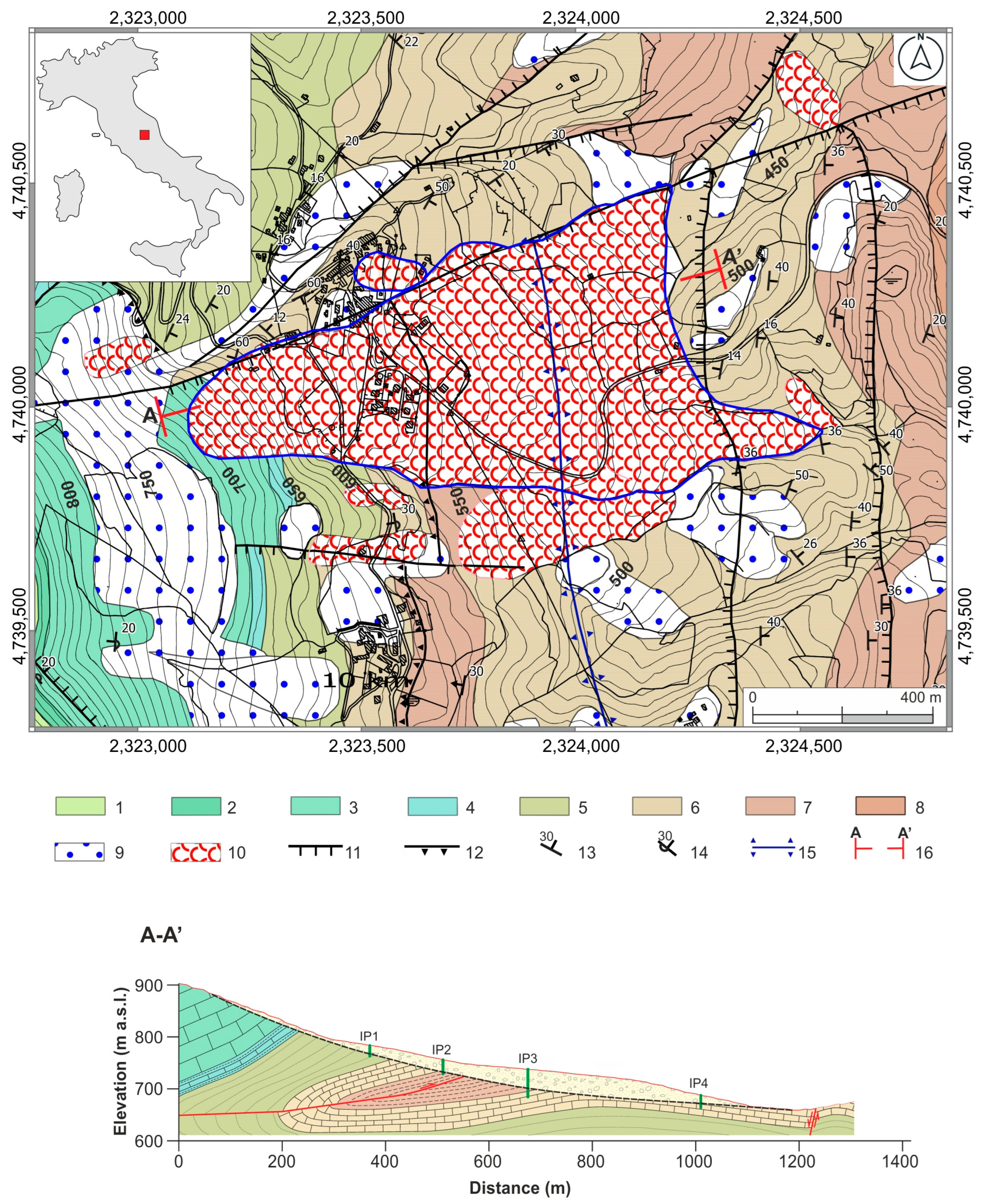
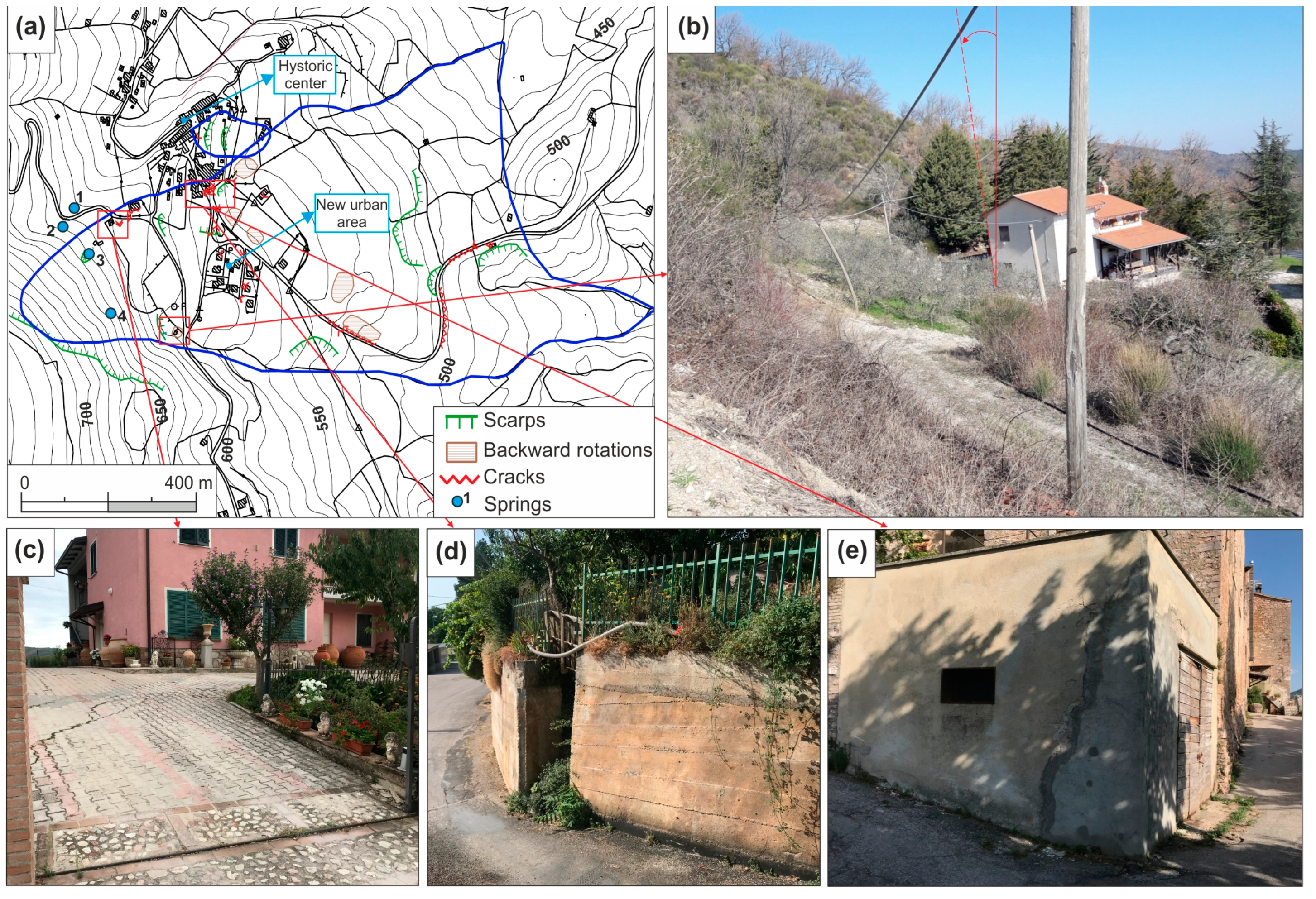
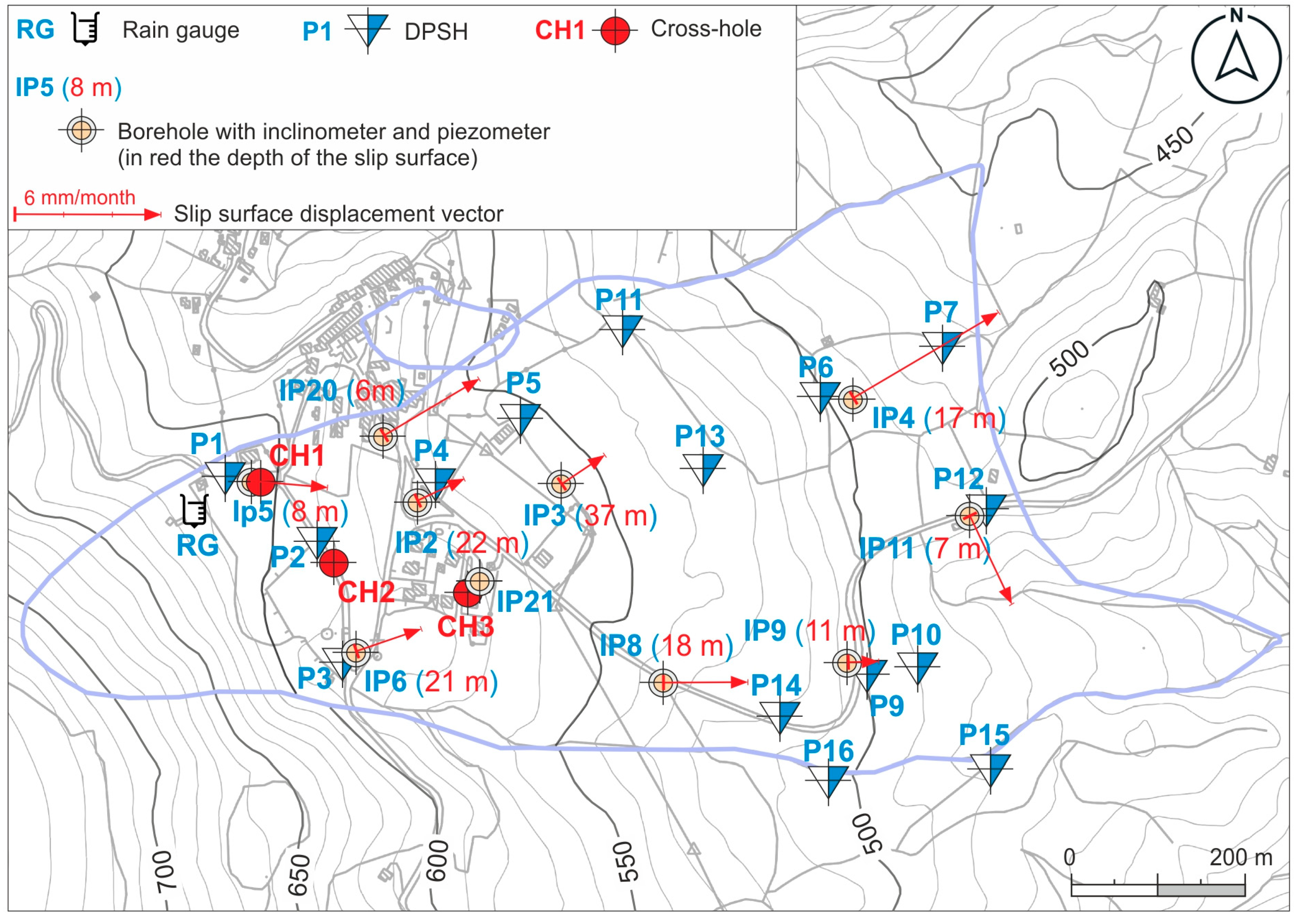

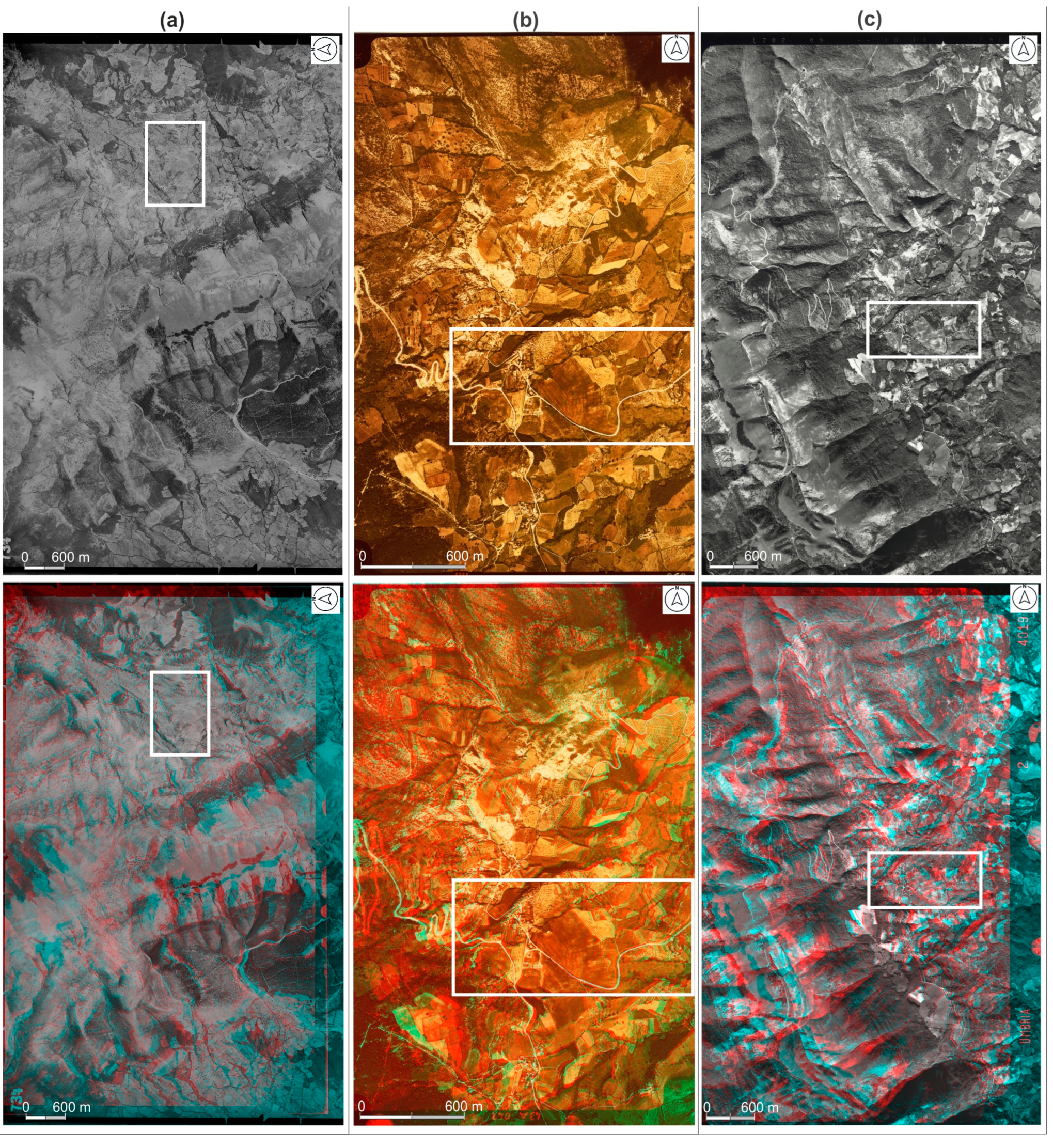
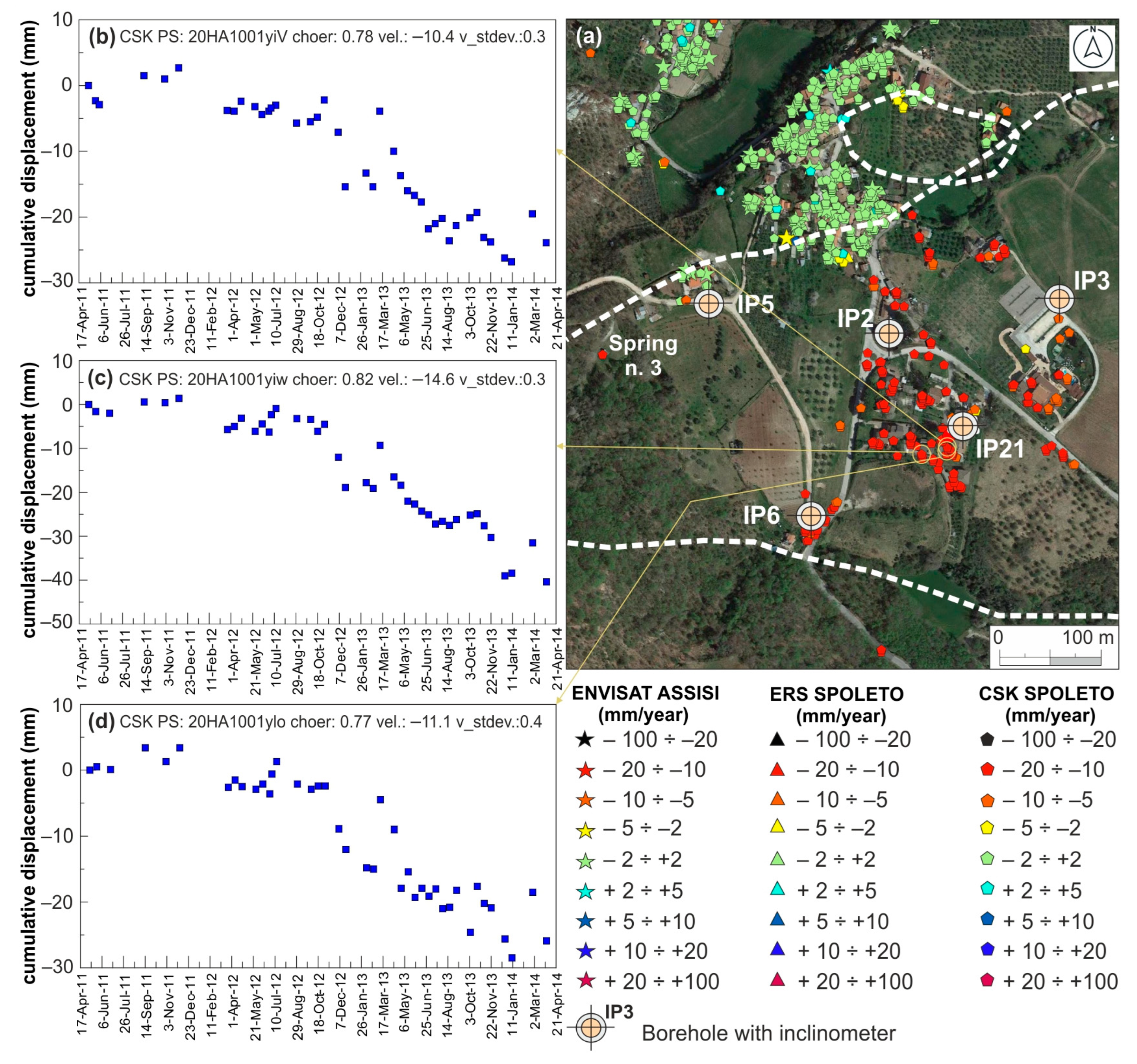
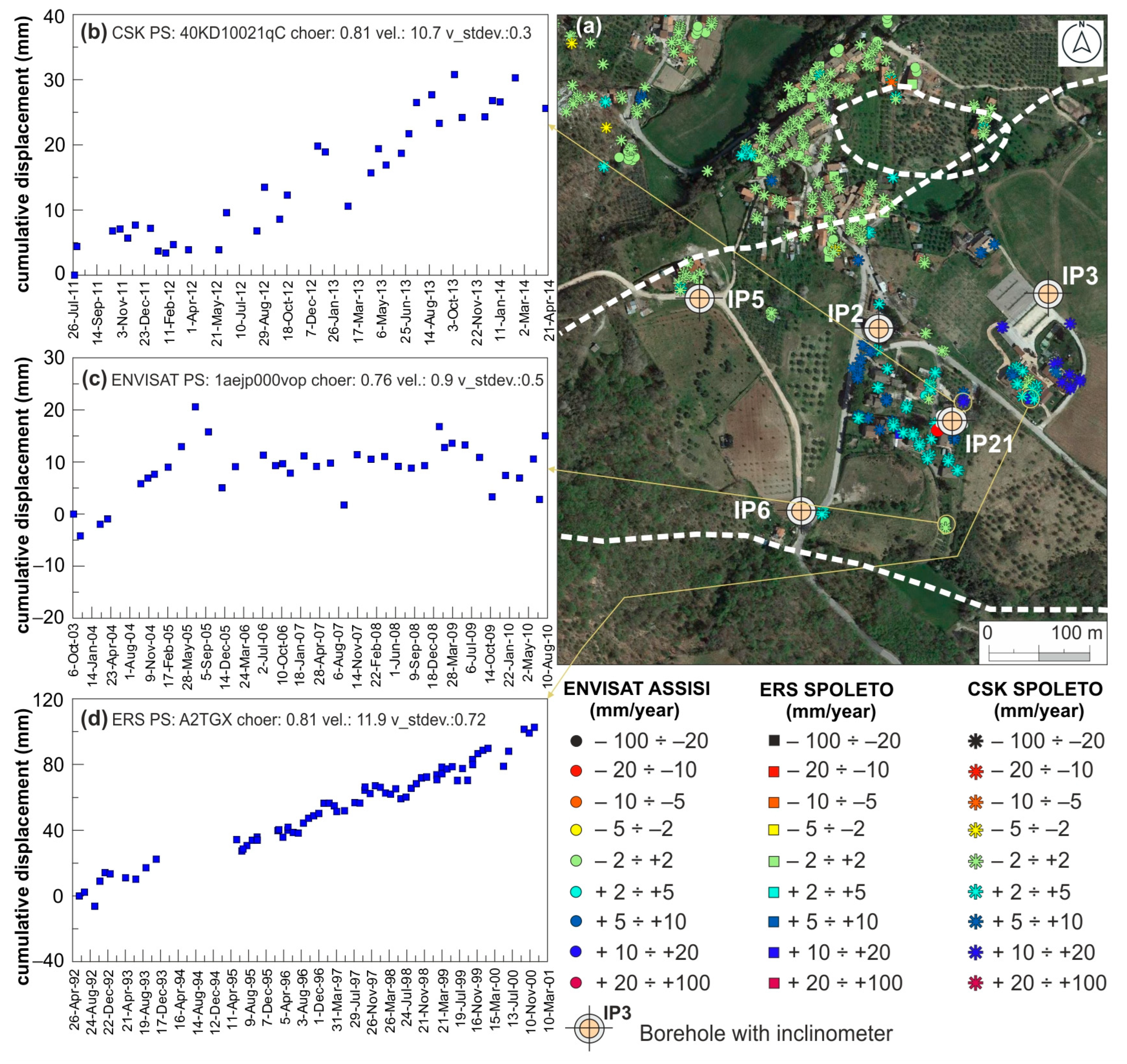

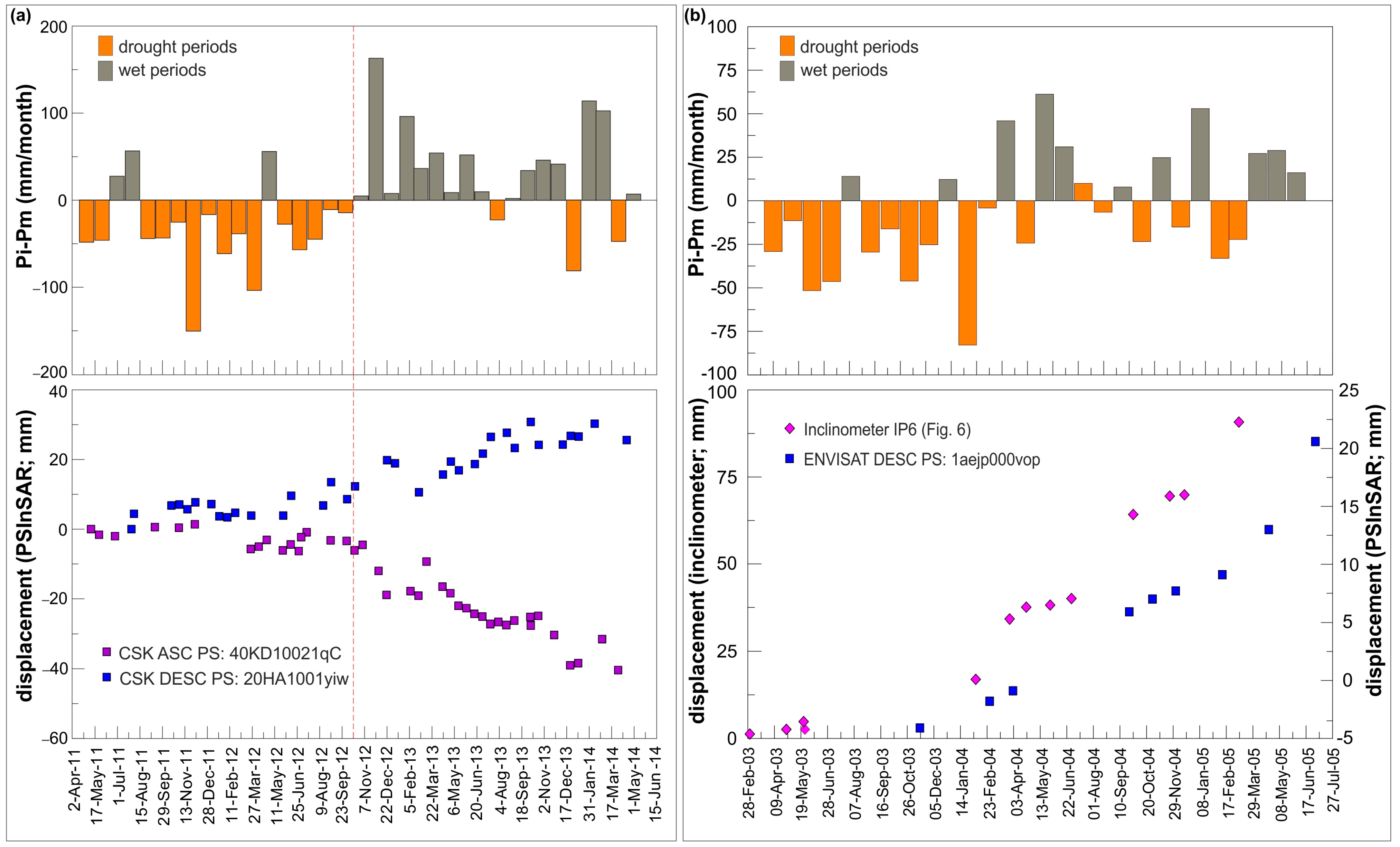
| Name | Type | Depth (m) | Monitoring Period or Test Execution Date |
|---|---|---|---|
| IP2 | Borehole with I and P | 27.3 | n. 3 acquisition during October 2003–April 2004 |
| IP3 | Borehole with I and P | 54.5 | n. 4 acquisition during January 2008–December 2008 |
| IP4 | Borehole with I and P | 23.5 | n. 8 acquisition during February 2003–May 2004 |
| IP5 | Borehole with I and P | 15.0 | n. 8 acquisition during February 2003–April 2004 |
| IP6 | Borehole with I and P | 23.0 | n. 14 acquisition during February 2003–March 2005 |
| IP8 | Borehole with I and P | 21.0 | n. 8 acquisition during March 2003–May 2004 |
| IP9 | Borehole with I and P | 18.0 | n. 6 acquisition during February 2003–February 2004 |
| IP11 | Borehole with I and P | 12.0 | n. 8 acquisition during February 2003–July 2004 |
| IP20 | Borehole with I and P | 17.0 | n. 8 acquisition during April 2003–June 2004 |
| IP21 | Borehole with I and P | 34.0 | n. 1 acquisition in 2018 |
| P1 | DPSH | 4.0 | 7 October 2002 |
| P2 | DPSH | 11.0 | 7 October 2002 |
| P3 | DPSH | 7.0 | 7 October 2002 |
| P4 | DPSH | 6.0 | 7 October 2002 |
| P5 | DPSH | 9.2 | 7 October 2002 |
| P6 | DPSH | 8.8 | 8 October 2002 |
| P7 | DPSH | 10.6 | 8 October 2002 |
| P9 | DPSH | 9.0 | 15 October 2002 |
| P10 | DPSH | 9.4 | 15 October 2002 |
| P11 | DPSH | 4.6 | 15 October 2002 |
| P12 | DPSH | 6.2 | 8 October 2002 |
| P13 | DPSH | 5.2 | 15 October 2002 |
| P14 | DPSH | 13.8 | 15 October 2002 |
| P15 | DPSH | 7.8 | 16 October 2002 |
| P16 | DPSH | 12.2 | 15 October 2002 |
| CH1 | Cross-hole | 50.0 | October 2002 |
| CH2 | Cross-hole | 50.0 | October 2002 |
| CH3 | Cross-hole | 50.0 | October 2002 |
| Type | Date | Scale | Executing Company | Flight Strips | Photograms |
|---|---|---|---|---|---|
| AR 06–“Volo GAI” B/W | 1954–55 | 1:33.000 | Istituto Geografico Militare | 32 33 | 733–734–735 929–930 |
| “Volo Umbria a colori” | 1977 | 1:13.000 | Compagnia Generale Riprese Aeree di Parma | 43A | 049–050 |
| “Volo AR34” B/W | 1996–1997 | 1:28.000 | Compagnia Generale Riprese Aeree di Parma | 2 | 4019–4020 |
| Satellite | Property | Revising Time (Days) | Resolution (Azimuth × Range) | Band | Period |
|---|---|---|---|---|---|
| ERS 1–2 | European Space Agency (ESA) | 35 | 20 × 5 m | C | 1992–2000 |
| ENVISAT | European Space Agency (ESA) | 35 | 20 × 5 m | C | 2003–2010 |
| Cosmo SkyMed (CSK) | Italian Space Agency (ASI) | 8 | up to 1 × 1 m | X | 2011–2014 |
Disclaimer/Publisher’s Note: The statements, opinions and data contained in all publications are solely those of the individual author(s) and contributor(s) and not of MDPI and/or the editor(s). MDPI and/or the editor(s) disclaim responsibility for any injury to people or property resulting from any ideas, methods, instructions or products referred to in the content. |
© 2023 by the authors. Licensee MDPI, Basel, Switzerland. This article is an open access article distributed under the terms and conditions of the Creative Commons Attribution (CC BY) license (https://creativecommons.org/licenses/by/4.0/).
Share and Cite
Di Matteo, L.; Cardinali, R.; Cerboni, V.; Guadagnano, F.; Piagnani, G.; Ribaldi, C.; Sotera, B.M.; Cencetti, C. Integrated Approaches for Field Mapping by Traditional Investigation and Satellite PSInSAR Data: Results from the Montemartano Landslide (Central Italy). Remote Sens. 2023, 15, 1221. https://doi.org/10.3390/rs15051221
Di Matteo L, Cardinali R, Cerboni V, Guadagnano F, Piagnani G, Ribaldi C, Sotera BM, Cencetti C. Integrated Approaches for Field Mapping by Traditional Investigation and Satellite PSInSAR Data: Results from the Montemartano Landslide (Central Italy). Remote Sensing. 2023; 15(5):1221. https://doi.org/10.3390/rs15051221
Chicago/Turabian StyleDi Matteo, Lucio, Riccardo Cardinali, Valentina Cerboni, Fabio Guadagnano, Giorgio Piagnani, Claudia Ribaldi, Biagio Marco Sotera, and Corrado Cencetti. 2023. "Integrated Approaches for Field Mapping by Traditional Investigation and Satellite PSInSAR Data: Results from the Montemartano Landslide (Central Italy)" Remote Sensing 15, no. 5: 1221. https://doi.org/10.3390/rs15051221
APA StyleDi Matteo, L., Cardinali, R., Cerboni, V., Guadagnano, F., Piagnani, G., Ribaldi, C., Sotera, B. M., & Cencetti, C. (2023). Integrated Approaches for Field Mapping by Traditional Investigation and Satellite PSInSAR Data: Results from the Montemartano Landslide (Central Italy). Remote Sensing, 15(5), 1221. https://doi.org/10.3390/rs15051221











